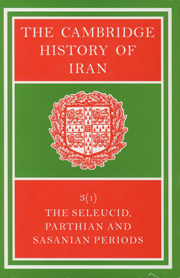Book contents
- Frontmatter
- Introduction
- PART 1 POLITICAL HISTORY
- PART 2 NUMISMATICS
- PART 3 IRANIAN HISTORICAL TRADITION
- PART 4 IRAN AND HER NEIGHBOURS
- 11 Iran and Mesopotamia
- 12 IRAN, ARMENIA AND GEORGIA
- 13 Iran and China
- 14 Cultural Relations between Parthia and Rome
- 15 Byzantium and the Sasanians
- 16 Iran and the Arabs before Islam
- 17 Irano-Turkish Relations in the Late Sasanian Period
- Bibliography
- Plate section
- Plate section
- Plate section
- Map 3. The western regions of the Sasanian empire">
- Map 11. The Silk Road from China to the Roman Orient
- References
17 - Irano-Turkish Relations in the Late Sasanian Period
from PART 4 - IRAN AND HER NEIGHBOURS
Published online by Cambridge University Press: 28 March 2008
- Frontmatter
- Introduction
- PART 1 POLITICAL HISTORY
- PART 2 NUMISMATICS
- PART 3 IRANIAN HISTORICAL TRADITION
- PART 4 IRAN AND HER NEIGHBOURS
- 11 Iran and Mesopotamia
- 12 IRAN, ARMENIA AND GEORGIA
- 13 Iran and China
- 14 Cultural Relations between Parthia and Rome
- 15 Byzantium and the Sasanians
- 16 Iran and the Arabs before Islam
- 17 Irano-Turkish Relations in the Late Sasanian Period
- Bibliography
- Plate section
- Plate section
- Plate section
- Map 3. The western regions of the Sasanian empire">
- Map 11. The Silk Road from China to the Roman Orient
- References
Summary
Firdausī's Shāh-nāma, completed at the beginning of the 11th century A.D. and incorporating epic material from earlier times, describes the battles between two equally courageous peoples, the Iranians and the Turanians. The word Tūrān is unrelated to the word Turk but since, from the 6th century on, the Turks, who had migrated from Central Asia, came to play a decisive role in the history of the Iranian peoples, by association it came to be applied – mistakenly – to these new arrivals.
At Panjikant in Sogdiana (in present-day Tājīkistān, 60 km east of Samarkand), there is a wall painting dating probably from the 8th century A.D., which depicts a scene of mourning for some young prince; near the catafalque are male mourners with brown hair and light skins, while a little further off, in the foreground, are others of a different ethnic type, having black hair, darker skin and prominent hooked noses. The two groups possibly represent Sogdians and Turks, but we cannot say for sure which is which (fig. 3, p. 1146).
Another wall painting of the same period, feom Afrāsiyāb (the northern part of the town of Samarkand) in Sogdiana, shows the dignified figure of an envoy mounted on a camel; the envoy's features – large, round eyes and a prominent nose – are those usually attributed to foreigners and in particular to the Sogdians by the Uigurs from Qočo (Turfan in the Tarim basin) (pls 142–3).
Keywords
- Type
- Chapter
- Information
- The Cambridge History of Iran , pp. 613 - 624Publisher: Cambridge University PressPrint publication year: 1983



